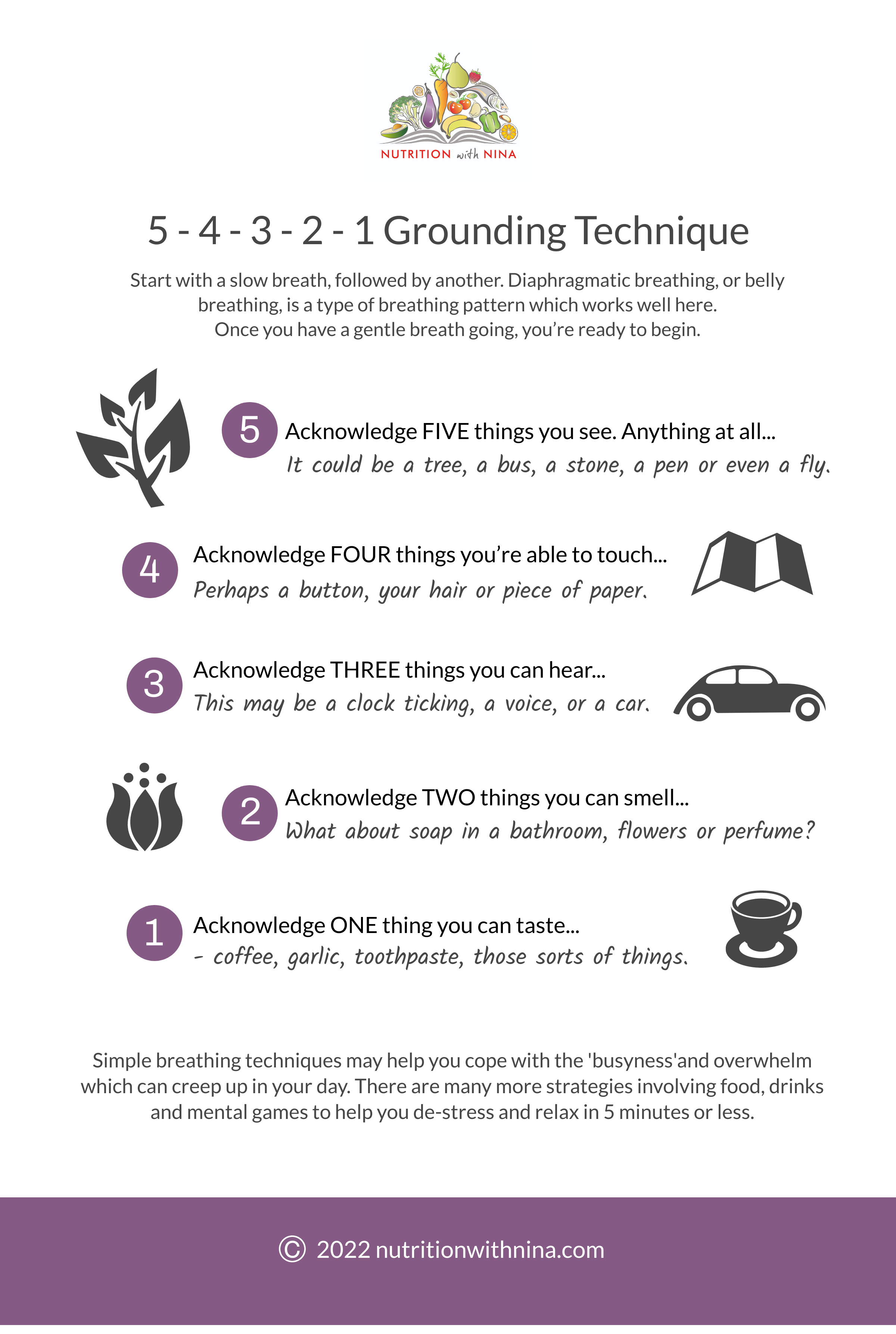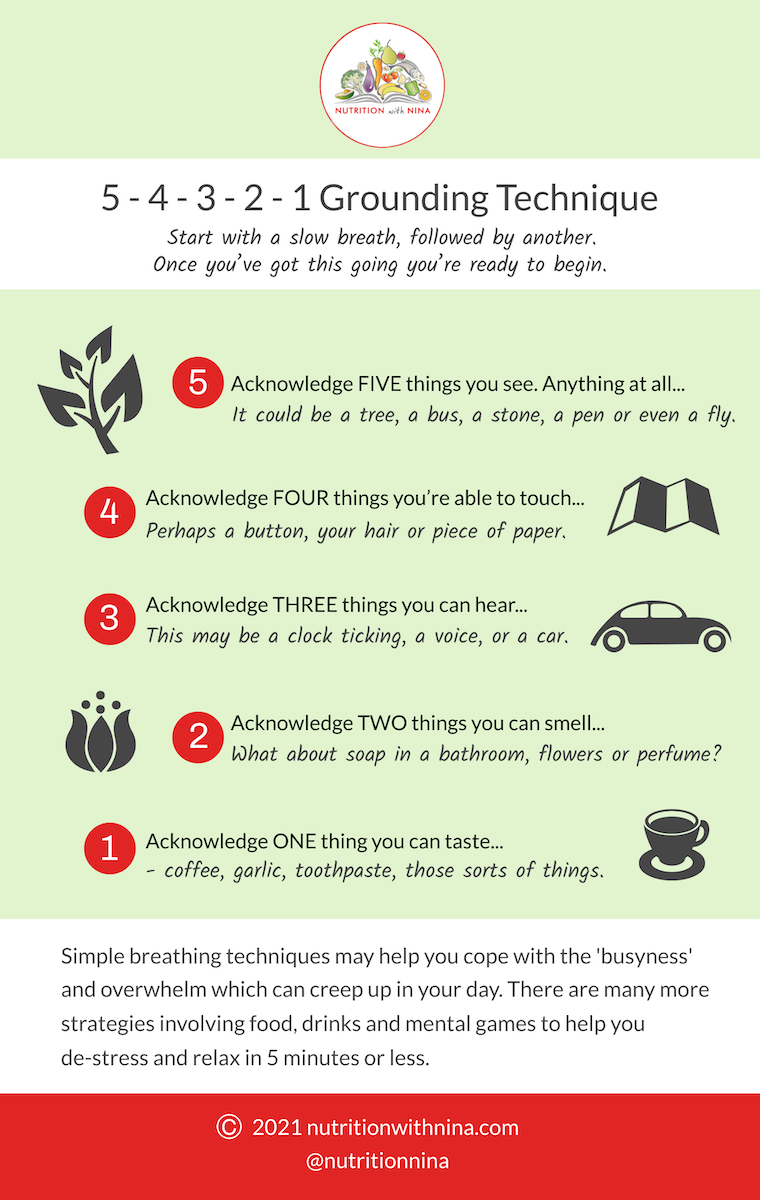
6 Effective Ways to Beat Stress and Relax – in 5 Minutes or Less
Why quick stress relief matters
Pressure in life is a given — but sometimes daily hassles pile up and leave you completely out of sorts.
Do you ever:
- Feel disinterested, disconnected or struggle to get going?
- Get dry-mouthed, sweaty or panicky for no real reason?
- Snap at small things or feel irritable all day?
These are signs that stress has tipped your hormones — cortisol and adrenaline — into overdrive. That can disrupt sleep, digestion, memory, mood, and even how your body manages energy and fat. Short, intentional resets can help bring your body and mind back into balance.
My personal quick resets
Over the years I’ve tried a lot of stress-busting tactics. Some stick, some don’t:
- I rely on a quick walk, a short stretch or a few minutes of dancing to get my heart pumping and muscles moving.
- I love my tea ritual, taking five minutes to brew and sip slowly — it signals to my body that it’s safe to relax.
- I’ve never been comfortable with the word “meditate,” and closing my eyes isn’t always an option — so I stick with simple counting, moving or sensory grounding instead.
6 quick stress-busting strategies
1. Have a bite to eat
Craving something sweet and baked? Try a spoonful of raw honey.
Why it works: Honey contains polyphenols and flavonols, which may reduce anxiety and improve memory. Steady natural sugars help prevent cortisol spikes that come with low blood sugar.
Bonus tip: Feeling jaw tension? Crunching celery helps relax your jaw muscles and supports digestion.
2. Get moving
You can raise your heart rate and move stress hormones in just a few minutes:
Go for a brisk walk
Do a stretch or a few simple exercises
Dance to a favourite track
Why it works: Cardiovascular movement temporarily boosts adrenaline and cortisol to cope with exercise, then clears them quickly — a healthy reset, unlike chronic stress which keeps them elevated.
3. Connect with your surroundings
Use your senses to anchor yourself in the present:
Try this: The 5–4–3–2–1 Technique — name 5 things you see, 4 you feel, 3 you hear, 2 you smell, 1 you taste
Personal approach: I often step outside, take a deep breath, or switch off notifications to remove small irritants and regain focus.

4. Go mental
Shift your attention away from negative thought loops:
Recite the alphabet backwards
Sing or hum an upbeat song
Try a “positive doodle dump” — write down worries, then cover the page with rainbows, flowers, smiley faces
Why it works: Redirects attention and stimulates mood-boosting neurotransmitters, countering the brain’s natural negativity bias.
5. Put the kettle on
Brewing tea can be a small act of mindfulness.
Why it works: Green tea contains l-theanine, which can calm brain waves and reduce excitatory signals.
Personal twist: I keep it simple — no pressure, no ritual bells or incense. Just hot water, leaves, and a quiet sip. Perfect for acute stress moments.
6. Take a deep breath
Calming doesn’t always mean strenuous effort.
Try this: 4–7–8 breathing — inhale 4 seconds, hold 7, exhale 8. Repeat until shoulders relax.
Personal tip: If closing your eyes feels uncomfortable, focus on your hands and count by tapping fingers with your thumb.
The Takeaway
A drizzle of olive oil can be a revolutionary act. Healthy doesn’t have to mean hard.

Targeted supplements for improving your energy.
This quick review covered 7 key nutrients that support your body’s natural energy-production engines.
Have you tried any of these supplements – or are you thinking about it?
Leave a comment below and let me know what’s worked for you, or what you’re curious to try!
Ariz Acharki at Unsplash
[2] Wu et al (2015) Low population selenium status is associated with increased prevalence of thyroid disease
Pressure in life is a given, but sometimes the daily hassle can add up and leave you completely out of sorts. Feeling disinterested, disconnected and that it’s hard to get going? Or dry mouthed, sweaty and panicked for no real reason? Or tense, irritable and easily upset over trivial things? These are all signals that the pressure and hassle have gotten out of hand. If your sleep is disturbed, your memory is poor and you’re reeling from a string of bad descisions then it could be a sign that you need some time to release the pressure and tension within.
It takes effort to understand your emotional and physical response to the ‘busyness’ of life and its weighty issues (such as politics, health, work, relationships – or the lack of them as a consequence of Covid-19!!). It also takes time to unravel the tightly wound knots. There’s a whole month dedicated to such issues – Stress Awareness Month 2021; Regain Connection, Certainty and Control – which can give you a practical place to start. However, when it comes to dealing with emotional pressures there are other areas to consider – such as everyday ‘busyness’ and brief annoyances. How might you deal with this? For example, as I was writing this blog post I found myself growing irritated and agitated: ‘Why was I being constantly disturbed!!??’ In the end, I used some of these tools to quickly destress.The following 6 strategies may relieve short-term pressure and overwhelm. They’re also practical enough to incorporate into a busy and hectic day.
1. HAVE A BITE TO EAT
If stress creates an urge to eat something sweet, baked and sugary then consider taking a spoonful of honey instead. Raw honey may not immediately spring to mind as a stress-relieving food, but several interesting studies suggest this may soon change. In animal models honey reduces anxiety and improves memory. [1, 2] It seems that non-nutritional compounds – such as polyphenols and flavonols – may be responsible for these neuropharmacological effects. [3] Other symptoms of extreme pressure can include muscular tension – you find yourself standing… fingers tensed… chest and neck rigid… jaw clamped firmly shut. A stick of celery may be in order. Biting, crunching and chewing gets your jaw muscles moving, helping to dissipate any tension. Celery is also a great vegetable when it comes to digestion, a process which is often compromised when pressure and overwhelm take hold.2. PUT THE KETTLE ON
5 minutes is more than enough time to boil a cup of water, brew a tea and take the first satisfying sip. If you drink green tea you’ll get a hit of l-theanine. This amino acid is believed to create its calming effects by increasing alpha wave patterns in your brain and decreasing levels of excitatory glutamate. L-theanine may be better for situations of acute stress, rather than long-lasting chronic states. [4]3. GET MOVING
There’s a well-evidenced link between exercise and coping with overwhelm, but how much exercise can you do in just 5 minutes? Surprisingly – quite a lot. Squats, lunges or jumping jacks could be done while you wait for the kettle to boil. You could march up and down the stairs (if you have them) when you’re in the office or at home. You could put on some music, crank the volume up and dance for an entire track. In 3 to 5 minures you’ll get your heart pumping and your muscles moving. Cardiovascular-type exercises like these also affect your hormones – causing a release of adrenaline and cortisol to help you cope with the stress of the exercise. However, the short-term release and quick clearance of these hormones is a healthy and desirable response, unlike in chronic-stress states where levels remain elevated and take a toll.4. TAKE A DEEP BREATH
Sometimes it doesn’t make any sense to add a strenuous activity – instead you want to calm things down. Personally, I’ve never cracked meditation, but I do know how to count to 8 which is why I first gave this breathing exercise a go. With 4 – 7 – 8 breathing you start by sitting (or standing) comfortably. Then inhale for 4 seconds – hold your breath for 7 seconds – and slowly exhale for 8 seconds. You can repeat this for as long as needed, or until your 5 minutes is up. Normally I feel my shoulders relax after the first few rounds. Also, sometimes I don’t like having my eyes closed, so I focus on my hands, tap each of my fingers in turn with a thumb, and do the counting this way instead. Exercise to try: 4 – 7 – 8 Breathing Exercise5. GO MENTAL
Interrupting the pattern of your thoughts can help you manage overwhelm and pressure, especially when it is driven by negative thoughts. Your brain develops with a negativity bias, the ability to focus more strongly on negative stimuli, recall them more easily, and give these memories greater importance. Which means that one off-hand remark or unexpected incidence can leave you stuck and stressed – replaying the event over and over again. Although this hard-wired bias can’t be adjusted, it’s possible to redirect your attention instead. With mind games for example. You might say the alphabet backwards from Z to A. You might recite the lyrics of a song (keep it upbeat!). Or you could do a positive doodle dump. Get your problems out of your head and write them all down. Then get doodling. Draw any feel-good symbols on the same sheet, such as rainbows, flowers, smiley faces.6. CONNECT WITH YOUR SURROUNDINGS
Practices such as the 5-4-3-2-1 Grounding Technique may help you use your senses to connect with your environment. If external demands and disturbances are a source of your irritation (as they were when I was writing this article), walk to a quieter space or switch off your phone before you begin. Technique to try:
